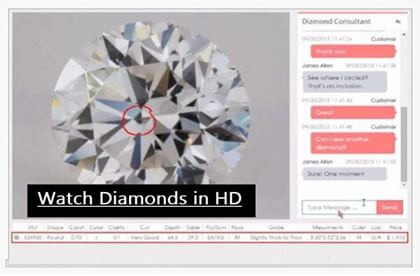In the sparkling world of diamonds, size is often the first thing that catches the eye. But determining the size of a diamond isn’t as straightforward as you might think. While ‘carat weight’ gives us a measure of a diamond’s size, it’s not the sole determinant. The actual dimensions, usually expressed in millimeters (mm), can also give an insight into how large a diamond appears when viewed from the top. In this comprehensive guide, we’ll delve into the nuances of round diamond sizes, from millimeters to carat weight, with insights from industry experts.

Understanding Diamond Dimensions
When discussing diamond dimensions, especially for round diamonds, we commonly refer to the diameter, measured in millimeters, across the widest part of the stone. As Gemologist Dr. Sara Mitchell explains, “While carat weight informs about a diamond’s size, understanding its diameter can offer insights into its spread and how it might appear once set in jewelry.”
The Interplay Between Carat and Size
Carat is a weight measure. Therefore, two diamonds both weighing 1 carat might not necessarily have the exact same diameter. Factors such as cut quality, depth, and overall proportions can influence this.
Round Diamond Size Chart: Approximate MM to Carat Weight
To help you visualize and understand the general relationship between millimeters and carat weight for round diamonds, here’s a simplified chart, backed by observations from seasoned gemologists:
| Diameter (mm) | Approximate Carat Weight |
|---|---|
| 1.0 mm | 0.005 carats |
| 1.5 mm | 0.015 carats |
| 2.0 mm | 0.03 carats |
| 2.5 mm | 0.06 carats |
| 3.0 mm | 0.10 carats |
| 3.5 mm | 0.15 carats |
| 4.0 mm | 0.25 carats |
| 4.5 mm | 0.33 carats |
| 5.0 mm | 0.50 carats |
| 5.5 mm | 0.60 carats |
| 6.0 mm | 0.80 carats |
| 6.5 mm | 1.00 carats |
| 7.0 mm | 1.25 carats |
| 7.5 mm | 1.50 carats |
| 8.0 mm | 2.00 carats |
| 8.5 mm | 2.50 carats |
| 9.0 mm | 3.00 carats |
| 9.5 mm | 3.50 carats |
| 10.0 mm | 4.00 carats |
Note: These are approximate values, and actual carat weight can vary based on the depth and cut of the diamond. The deeper the diamond, the more it might weigh for a given diameter.
It’s important to note that these are average measures. As expert diamond dealer, Robert Laine emphasizes, “Each diamond is unique. While charts provide a good starting point, there are always exceptions based on a diamond’s individual characteristics.”
Why MM Measurements Matter
Diamonds are often set into rings, earrings, or other pieces of jewelry. The visual impression created by the diamond can be significantly influenced by its diameter in millimeters. A diamond with a larger spread (greater mm measurement for its carat weight) may appear larger than another diamond of the same weight but with a smaller spread.
Factors Influencing the MM-Carat Relationship
- Cut Quality: A deep or shallow cut diamond may have a smaller diameter than one that’s ideally cut, even if they share the same carat weight.
- Shape and Symmetry: Even slight asymmetry can influence the diamond’s diameter, affecting its appearance.
- Girdle Thickness: A very thick or extremely thin girdle can modify the diameter-to-carat relationship.
Concluding Thoughts
While the carat weight of a diamond holds undeniable importance, understanding its dimensions in millimeters can offer a more comprehensive view of its size and appearance. Whether you’re a first-time buyer or a diamond connoisseur, being armed with this knowledge can assist in making informed decisions. As always, when purchasing a diamond, it’s recommended to seek opinions from trusted experts and rely on certified measurements and grading.



